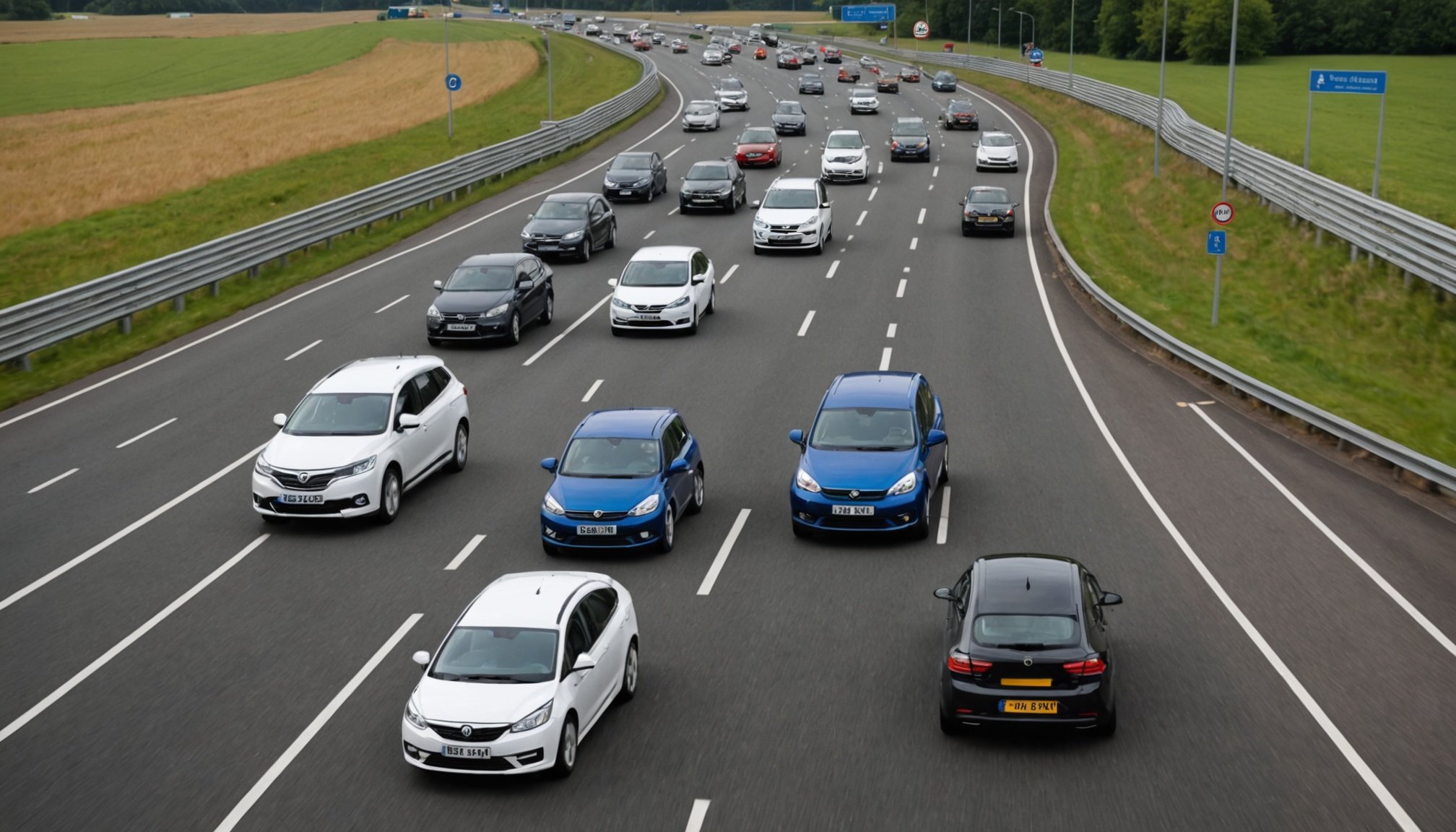Unlocking Lane-Keeping Assist: Top Strategies for Safer Driving on UK Roads
Understanding Lane-Keeping Assist Technology
Lane-keeping assist is a cutting-edge feature of Advanced Driver Assistance Systems (ADAS) that has revolutionized the way we drive. This technology uses a combination of sensors, cameras, and artificial intelligence to help drivers stay within their lane, reducing the risk of accidents caused by driver distraction or fatigue.
How Lane-Keeping Assist Works
Lane-keeping assist systems typically employ cameras mounted on the windshield or rearview mirror to monitor the road markings and the vehicle’s position within the lane. If the vehicle drifts out of its lane without the turn signal being activated, the system alerts the driver through a warning signal, such as a vibration in the steering wheel or an audible alert. In some advanced systems, the vehicle can even autonomously steer itself back into the lane.
Also to discover : Maximize safety: essential tips for seamlessly integrating child car seats with your vehicle’s safety features
### Key Components of Lane-Keeping Assist
- **Cameras**: Capture images of the road and lane markings.
- **Sensors**: Detect the vehicle's position and speed.
- **Artificial Intelligence**: Analyzes data to determine if the vehicle is drifting out of its lane.
- **Steering Wheel**: Provides feedback to the driver through vibrations or adjustments.
- **Alert Systems**: Warns the driver through audible or visual signals.
Benefits of Lane-Keeping Assist for Road Safety
The integration of lane-keeping assist into modern vehicles has significant implications for road safety.
Reduced Accident Rates
Studies have shown that vehicles equipped with lane-keeping assist and other ADAS features experience a substantial reduction in accident rates. For instance, lane departure warning systems can lower single-vehicle and head-on crashes by 11% and related injury crashes by a notable margin[3].
In parallel : Maximizing backup sensor performance in city driving: essential tips for smart drivers
Enhanced Driver Comfort and Focus
Lane-keeping assist helps drivers maintain their focus on the road by reducing the need for constant steering adjustments. This is particularly beneficial during long highway drives, where driver fatigue can be a significant risk factor.
Compliance with Traffic Rules
These systems also help drivers comply with traffic rules by identifying and responding to lane markings and other road signs. This feature is especially useful in areas with frequently changing traffic rules, helping reduce violations and improve overall road safety[3].
Practical Tips for Using Lane-Keeping Assist Effectively
To get the most out of lane-keeping assist and ensure safe driving, here are some practical tips:
Stay Focused and Minimise Distractions
While lane-keeping assist is a powerful tool, it is not a substitute for attentive driving. Avoid distractions such as using your phone, eating, or adjusting the radio while driving. These distractions can impair your ability to react to sudden changes in traffic or road conditions[4].
Maintain Vehicle Maintenance
Ensure your vehicle is properly maintained, including the cameras and sensors used by the lane-keeping assist system. Regularly clean the cameras and check for any software updates to ensure the system functions optimally.
Understand System Limitations
It’s crucial to understand the limitations of lane-keeping assist. The system may not function correctly in poor weather conditions, on roads without clear markings, or in construction zones. Always be prepared to take control of the vehicle if the system is not functioning as expected.
Integrating Lane-Keeping Assist with Other Safety Features
For maximum safety, lane-keeping assist should be used in conjunction with other advanced safety features.
Adaptive Cruise Control
Adaptive cruise control maintains a safe following distance by automatically adjusting the vehicle’s speed based on traffic conditions. When used alongside lane-keeping assist, this feature can significantly enhance driver comfort and safety during highway driving[3].
Blind Spot Warning
Blind spot warning systems alert drivers to vehicles in their blind spots, reducing the risk of accidents during lane changes. This feature complements lane-keeping assist by providing a comprehensive safety net while driving[3].
Automatic Emergency Braking
Automatic emergency braking can prevent or mitigate rear-end collisions by automatically applying the brakes if the system detects an imminent collision. This feature works in tandem with lane-keeping assist to provide an additional layer of safety[3].
Real-World Examples and Success Stories
Several real-world examples and studies highlight the effectiveness of lane-keeping assist in enhancing road safety.
Case Study: UK Motorways
On UK motorways, particularly those with smart motorway features, lane-keeping assist has been instrumental in reducing accidents. Smart motorways use advanced technology, including variable speed limits and electronic lane control signals, to manage traffic flow. When combined with lane-keeping assist, these systems can significantly reduce congestion and the risk of accidents[1].
Data from ADAS Studies
Studies on ADAS effectiveness have shown that vehicles equipped with lane-keeping assist and other safety features experience a lower crash rate. For example, vehicles with lane departure warning have an 18% lower crash rate and 24% fewer injury crashes compared to those without these features[3].
Future of Automated Driving and Lane-Keeping Assist
As technology continues to evolve, the future of driving is likely to be more automated, with lane-keeping assist playing a central role.
Self-Driving Cars
Self-driving cars, which are being developed and tested globally, rely heavily on advanced ADAS features like lane-keeping assist. These vehicles use a combination of sensors, cameras, and AI to navigate roads safely and efficiently.
Enhanced Safety Features
Future vehicles are expected to include even more advanced safety features, such as improved lane-keeping assist systems that can handle more complex road scenarios. Additionally, features like stopped vehicle detection (SVD) and automated enforcement of “red X” signals will further enhance road safety[1].
Lane-keeping assist is a powerful tool in the arsenal of road safety features available to drivers today. By understanding how this technology works, its benefits, and how to use it effectively, drivers can significantly reduce their risk of being involved in an accident.
Key Takeaways
- Use Lane-Keeping Assist in Conjunction with Other Safety Features: Combine lane-keeping assist with adaptive cruise control, blind spot warning, and automatic emergency braking for enhanced safety.
- Stay Focused and Minimise Distractions: Avoid distractions while driving to ensure you can react to any situation that may arise.
- Maintain Your Vehicle: Regularly check and maintain the cameras and sensors used by the lane-keeping assist system.
- Understand System Limitations: Be aware of the conditions under which the system may not function correctly.
By embracing these strategies and technologies, we can make our roads safer for all road users.
### Comparative Table: ADAS Features and Their Benefits
| ADAS Feature | Benefit | Market Penetration |
|
|------------------------------------------------------------------------|
|
| Lane Departure Warning | Reduces single-vehicle and head-on crashes by 11% | Over 50% |
| Automatic Emergency Braking| Reduces rear-end collisions by approximately 40% | Over 90% |
| Adaptive Cruise Control | Maintains safe following distance, improves driver comfort | Over 50% |
| Blind Spot Warning | Alerts drivers to vehicles in their blind spots | Over 50% |
| Stopped Vehicle Detection | Automatically detects and responds to stopped vehicles | Implemented on ALR motorways by 2022 |
Additional Resources
For those interested in learning more about lane-keeping assist and other ADAS features, here are some additional resources:
- Watch Video: Many car manufacturers provide detailed videos explaining how their ADAS features work.
- Highway Code: The UK Highway Code includes sections on using advanced safety features while driving.
- Car Insurance: Some car insurance providers offer discounts for vehicles equipped with ADAS features.
- New Car Reviews: Check reviews of new cars to see which models come with advanced safety features like lane-keeping assist.
By staying informed and utilizing these technologies effectively, we can all contribute to safer roads and a better driving experience.











